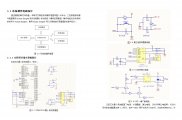物联网环境下的家电控制系统开发

物联网环境下的家电控制系统开发(论文13000字)
摘 要
近几年,物联网及其相关技术的出现,进一步扩大了智慧城市的发展领域,其中智能家居领域为智慧城市的建设提供了巨大的发展机会。在此背景下,本文通过首先分析智能家居的国内外发展和研究现状,并对智能家居存在的问题进行了分析和总结。然后根据家电的实际情况,设计出采用WiFi技术进行网络通讯的远程家电控制系统。最后,通过系统测试,验证了该系统的可行性。
本文设计的基于物联网环境下的家电远程控制系统包括电灯和空调两部分。远程通信主要通过WiFi模块来实现。电灯控制部分主要通过照明模块来实现。空调控制部分主要通过温湿度模块和空调模块来实现,空调模块的功能主要有制冷、加热、查询温度、设置温度。
在系统设计中,首先对系统总体方案进行设计,明确系统要实现的结构与功能。系统的组成分为硬件设计和软件设计两部分。硬件设计部分包含了芯片选型和系统硬件电路图的设计。本系统的主控芯片采用ST公司生产的STM32F103VET6,该芯片具有低功耗、高性能、高性价比等优点。软件设计部分包括系统整体软件设计和各个模块的驱动软件设计。系统的整体软件设计主要针对系统的软件总体流程进行设计。各个模块的驱动软件设计则包括了WiFi模块、温湿度模块、空调模块等模块的驱动软件设计。 [资料来源:Doc163.com]
最后对系统进行检验和测试。检验测试包括整个系统的测试和各个模块的测试,测试结果表明本系统符合远程家电控制的要求。
关键词:STM32;智能家居;环境监测;家电控制
Abstract
In recent years, the emergence of Internet of things and related technologies, further expanded the development of smart city areas, including the smart home field for the construction of smart city provides a huge opportunity for development. In this context, this paper first analyzes the development and research status of smart home at home and abroad, and analyzes and summarizes the existing problems of smart home. Then, according to the actual situation of home appliances, a remote home appliance control system based on WiFi technology for network communication is designed. Finally, the feasibility of the system is verified by system testing.
In this paper, the design of remote control system based on the Internet of things, including lighting and air conditioning in two parts. Remote communication is achieved mainly through the WiFi module. The light control part is mainly realized by lighting module. The air conditioning control part is mainly realized by the temperature and humidity module and the air conditioning module. The function of the air conditioning module is mainly cooling, heating, inquiring the temperature and setting the temperature.
[版权所有:http://DOC163.com]
In the system design, first of all, the overall design of the system is designed, and the structure and function of the system are defined. The system is composed of two parts: hardware design and software design. The hardware design part includes the chip selection and the design of the system hardware circuit. The main control chip of this system adopts STM32F103VET6 produced by ST company. The chip has many advantages, such as low power consumption,high performance, high cost performance and so on. The software design part includes the whole system software design and the drive software design of each module. The overall software design of the system is mainly to design the overall software flow of the system, and the driver software design of each module includes the WiFi module, temperature and humidity module, air conditioning module and other modules of the driver software design.
Finally, the system is tested and tested. The test includes the whole system test and the test of each module. The test results show that the system meets the requirements of home appliance control.
[资料来源:http://Doc163.com]
Key Words:STM32; smart home; environmental monitoring; home appliance control
[来源:http://Doc163.com]


目 录
摘 要 I
Abstract II
第1章 绪论 1
1.1 课题的研究背景及意义 1
1.2 国内外研究现状 1
1.3 智能家居产品目前存在问题 2
1.4 研究内容及论文结构 3
1.4.1 研究内容 3
1.4.2 论文结构 3
第2章 远程家电控制系统的总体方案设计 4
2.1 远程家电控制系统的方案设计 4
2.2 系统的方案及功能设计 4
第3章 系统硬件设计 6
3.1 主要芯片的选择 6
3.1.1 主控制器芯片的选择 6
3.1.2 WIFI模块芯片的选择 6
3.2 系统硬件电路设计 9
3.2.1 主控芯片最小系统设计 9
3.2.2 电源模块 12
3.2.3 WiFi模块 12
3.2.4 温湿度模块 13
3.2.5 照明模块和空调模块 13
3.3 本章小结 14
第4章 系统驱动程序设计 15
4.1系统整体软件设计 15
4.2 开发软件的选用 15
4.3 通用输入输出口配置 16
4.4 各模块驱动设计 17
4.4.1 WiFi模块 17
4.4.2 温湿度模块 20
4.4.3 照明模块和空调模块 22
4.4.4 通信模块 23
4.5 本章小结 25
第5章 系统测试结果 26 [来源:http://Doc163.com]
5.1 WiFi模块测试 26
5.2 温湿度模块测试 27
5.3 空调模块测试 28
5.4 照明模块测试 30
5.5 本章小结 31
第6章 总结和展望 32
参考文献 34
致 谢 36 [资料来源:Doc163.com]
